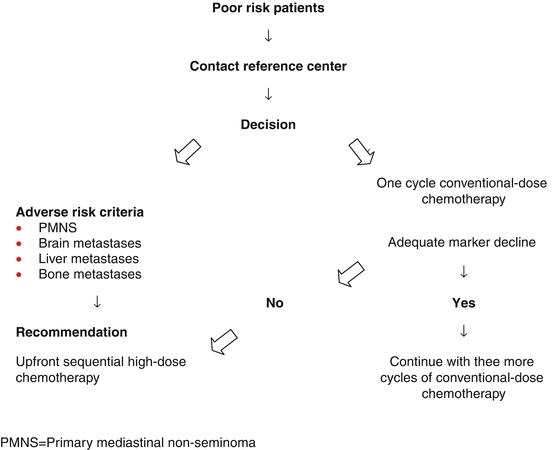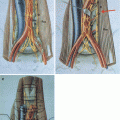“Good risk” (about 56 % of patients) >90 % survival probability
Clinical presentation
Low marker profile
Non-seminoma
Gonadal or retroperitoneal primary tumor
and
No extrapulmonary visceral metastases
AFP < 1,000 ng/ml
HCG < 5,000 U/l
LDH < 1.5 × normal
Seminoma
Any primary tumor location
and
No extrapulmonary visceral metastases
Intermediate risk (about 28 % of patients) ~78 % survival probability
Clinical presentation
Intermediate marker profile
Non-seminoma
Gonadal or retroperitoneal primary tumor
and
No extrapulmonary visceral metastases
AFP 1,000–10,000 ng/ml
HCG 5,000–50,000 U/l
LDH 1.5–10 × normal
Seminoma
Any primary tumor location
plus
Extrapulmonary visceral metastases
Intermediate risk (about 16 % of patients) ~45 % survival probability
Clinical presentation
Intermediate marker profile
Non-seminoma
Mediastinal primary tumor
or
Extrapulmonary visceral metastases
AFP > 10,000 ng/ml
HCG > 50,000 U/l
LDH > 10 × normal
However, despite its undisputable merits, the IGCCCG classification has several problems that require an updated classification system in the near future. First, the IGCCCG classification is mainly based on treatments that have been performed prior to 1990, which would no longer be considered acceptable today. In actual fact, in the IGCCCG database, not all patients even had received cisplatin, and only a fraction of patients had received etoposide as part of their first-line treatments. Second, many improvements in diagnostic staging procedures have resulted in stage migration. Third, better supportive care has led to significant improvements in overall survival probabilities across all risk categories [6]. Fourth, and most importantly, several analyses have shown that the intermediate-risk and the poor-risk categories comprise of quite heterogeneous subsets of patients. Particularly patients with liver, bone, and brain metastases at initial diagnosis as well as patients with primary mediastinal non-seminoma have a significantly worse prognosis compared to patients classified as having “poor-risk” disease based on serum tumor marker elevations alone [7].
8.3 Early Identification of Unfavorable Response to First-Line Treatment
Over almost two decades, the prognostic impact of the decline of serum tumor markers after initiation of chemotherapy has been subject to considerable debate [8, 9]. However, only recently, it could be shown that the rate of decline of the serum tumor markers AFP and HCG according to their estimated serum half-lives can be used to further subdivide the groups of intermediate- and poor-risk patients. In a prospective intergroup phase III trial in the United States that randomized intermediate-risk and poor-risk patients to conventional-dose and high-dose first-line chemotherapy, it showed that those patients with a slow marker decline beyond the estimated marker half-life of AFP and HCG had inferior survival probabilities and profited more from treatment intensification compared to patients with marker declines according to their estimated marker half-lives [10]. This observation was recently confirmed in a randomized trial from the French Testicular Cancer Study Group that prospectively stratified patients according to their decline of serum AFP and HCG after an initial cycle of chemotherapy [11]. In this trial, patients with a slow marker decline had an inferior survival probabilities that could be significantly improved by early treatment intensification (see also Chap. 5). The German Testicular Cancer Study Group uses this information for an integrated, rational approach for first-line treatment of poor-risk patients (Fig. 8.1). An unresolved question, however, is the optimal calculation method of marker decline, which differed in the abovementioned trials and resulted in conflicting results depending on the algorithm used [12].


Fig. 8.1
Algorithm for first-line treatment according to marker decline. PMNS primary mediastinal non-seminoma
8.4 Prognostic Factors in Recurrent Disease
Prognostic factors have long been recognized to impact strongly on the results of first-salvage chemotherapy and have been the focus of several retrospective analyses [13–15]. In the first-salvage setting, the importance of prognostic factors is even greater as compared to initial diagnosis.
Although consistent prognostic variables have been identified, previous analyses suffered from substantial limitations. All have been too small to identify but a few variables reliably; some databases contained only incomplete information and were without source data verification; often external or internal validation of the results was missing; many analyses were based on outdated treatments that would no longer be considered standard today. Many of these obstacles have been overcome by the recent large collaboration of the International Prognostic Factor Study Group that included more than 1,500 patients in an analysis of prognostic factors for first-salvage treatment [15]. Seminoma histology was identified as a favorable prognostic factor. Adverse prognostic factors were (1) extragonadal primary tumors, in particular primary mediastinal non-seminomas; (2) less than complete remission or less than tumor-marker-negative partial remission to first-line treatment; (3) a progression-free interval of three months or less; (4) elevations of AFP at salvage, particularly if more than 1,000 ng/ml; (5) elevation of HCG at salvage to more than 1,000 U/l; and (6) the presence of liver, bone, or brain metastases (Table 8.2).
Table 8.2
Prognostic factors for survival after first-salvage treatment of seminoma and non-seminoma patients (Ref. [15])
Score points | |||||
|---|---|---|---|---|---|
0 | 1 | 2 | 3 | Score | |
Primary site | Gonadal | Extragonadal | – | Mediastinal Non-seminoma | |
Prior response | CR/PRm− | PRm+/SD | PD | – | |
PFI | >3 months
Stay updated, free articles. Join our Telegram channel
Full access? Get Clinical Tree
 Get Clinical Tree app for offline access
Get Clinical Tree app for offline access

| ||||


